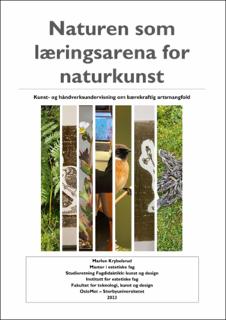| dc.contributor.advisor | Maus, Ingvill Gjerdrum | |
| dc.contributor.advisor | Solbø, Hildegunn | |
| dc.contributor.author | Krybelsrud, Marlen | |
| dc.date.accessioned | 2023-11-24T08:11:43Z | |
| dc.date.available | 2023-11-24T08:11:43Z | |
| dc.date.issued | 2023 | |
| dc.identifier.uri | https://hdl.handle.net/11250/3104456 | |
| dc.description.abstract | This master's thesis examines the potentials and challenges that arise when teaching the elementary school subject of arts and crafts is moved out of the classroom and into the school's nearest natural area. Based on Land Art and the local diversity of species, I have developed a teaching program as part of my case study. In light of the UN's Sustainable Development Goals and the decline in biological diversity, I aim to investigate how Land Art can shed light on this issue. The research question is:
What are the potentials and challenges of nature as a learning environment for Land Art concerning sustainable species diversity?
I have conducted a qualitative single-case study with a 7th-grade class in Oslo, which includes a two-day teaching program. The first part of the teaching program involves preparing for Land Art, where the students work on sketches of a locally chosen species. The second part involves constructing Land Art in the school's local environment. I utilized participant observation and semi-structured interviews as data collection methods. In the analysis process, I applied the hermeneutic circle and used main categories and sub- categories. The findings on potentials and challenges are discussed in relation to the theoretical framework, which includes sustainable didactics in art and crafts by Illeris, Näumann & Riis (2020), Frøyland & Remmen's theories on alternative learning environments (2011), and Sørenstuen's perspectives on aesthetic work in nature (2011).
Nature as a learning environment shows potentials in terms of concretizing and contextualizing knowledge, both about formal aesthetic techniques and species diversity. Findings indicate that the relevance of the subject of arts and crafts was a challenge when using nature as a learning environment, as this was something the students associated with natural science. It is important to have good planning and structured pre- and post- work to ensure that students get the most learning outcome from the teaching. Season and climatic conditions are challenges that were evident and affect the availability of colors and materials for the students. Nature as a learning environment can advantageously be used during the summer months, from spring to late summer. | en_US |
| dc.description.abstract | Denne masteravhandlingen tar for seg potensialer og utfordringer som oppstår når undervisningen i grunnskolefaget kunst og håndverk flyttes ut av klasserommet og til skolens nærmeste naturområde. Med utgangspunkt i naturkunst og det lokale artsmangfoldet har jeg utformet et undervisningsopplegg som en del av min casestudie. På bakgrunn av FNs bærekraftsmål og nedgangen av biologisk mangfold ønsker jeg å undersøke hvordan naturkunst kan belyse tematikken. Problemstillingen er som følgende:
Hvilke potensialer og utfordringer har naturen som læringsarena for naturkunst om bærekraftig artsmangfold?
Jeg har gjennomført en kvalitativ singel-casestudie med en 7.klasse i Oslo, som inneholder et undervisningsopplegg som går over to dager. Første del av undervisningsopplegget er forarbeid med naturkunst, der elevene arbeider med skissering av en selvvalgt lokal art. Andre del av undervisningsopplegget er konstruksjonen av naturkunst i skolens lokalmiljø. Som datainnsamlingsmetode benyttet jeg meg av deltakende observasjon og semistrukturert intervju. Jeg tar utgangspunkt i den hermeneutiske sirkelen i analyseprosessen og har kommet frem til hovedkategorier og subkategorier. Funnene om potensialer og utfordringer drøftes opp mot det teoretiske rammeverket som blant annet består av bærekraftsdidaktikk i kunst og håndverk fra Illeris, Näumann & Riis (2020), Frøyland & Remmens teorier om alternative læringsarenaer (2011) og Sørenstuens perspektiver på estetisk arbeid i naturen (2011).
Naturen som læringsarena viser seg å ha potensialer når det gjelder å konkretisere og kontekstualisere kunnskap, både om formalestetiske virkemidler og om artsmangfold. Elevene fikk også bli kjent med sitt lokalmiljø, gjennom estetiske kvaliteter og lokale arter. Funn viser at relevansen for faget kunst og håndverk var en utfordring ved bruk av naturen som læringsarena, da dette var noe elevene forbandt med naturfag. Det viser seg at det er viktig med god planlegging og et strukturert for- og etterarbeid. På den måten får elevene mest læringsutbytte av undervisningen. Årstid og klimatiske forhold er utfordringer som viste seg, og påvirker hvilke farger og materialer som er tilgjengelig for elevene. Naturen som læringsarena kan med fordel benyttes i sommerhalvåret, fra vår til sensommer. | en_US |
| dc.language.iso | nob | en_US |
| dc.publisher | OsloMet-Storbyuniversitetet | en_US |
| dc.title | Naturen som læringsarena for naturkunst Kunst- og håndverksundervisning om bærekraftig artsmangfold | en_US |
| dc.type | Master thesis | en_US |
| dc.description.version | publishedVersion | en_US |
